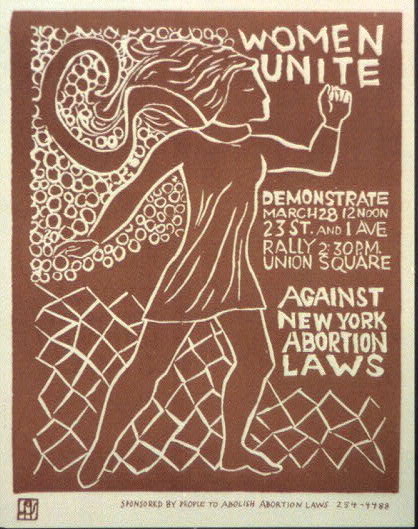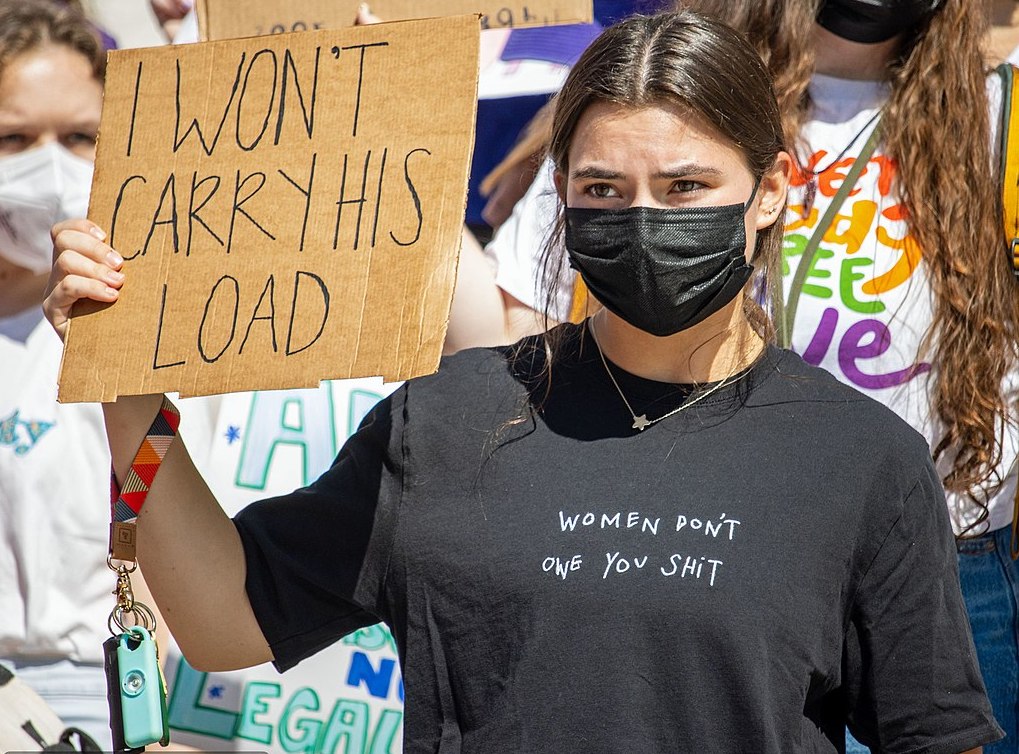On October 2, thousands of marchers took part in over 600 demonstrations across the country challenging the increasing threat to Roe v. Wade in the aftermath of Texas’ so-called “heartbeat” law, SB8, which amounts to a near-total ban on abortion in the state and vastly extends the criminalization of abortion, abortion seekers, supporters, and providers, while offering no exceptions for incest or rape.
After forty years of bipartisan neoliberal assault and a contradictory but concomitant right-wing political advance, one of the most glaring realities of U.S. politics centers on abortion rights and the state of the fight for abortion justice. Whether analyzed along the axis of feminist politics, or racial justice, or public health, or social reproduction, the loss of ground is stunning.
The balancing test spelled out by the Supreme Court in 1973 in Roe v. Wade has become the merest facade. The right to privacy and bodily autonomy has been circumscribed by decades of a right-wing assault and the most ambivalent defenses of these rights from the Democratic Party.
The slogan “safe, legal, and rare”— coined by the master triangulator and sexual predator Bill Clinton in the 1990s and then famously wielded by Hillary Clinton in 2008 — transformed an argument about a pregnant person’s rights to control over their body into a meditation on the responsibilities of the state. It epitomized the Party’s ambivalent defense of abortion, even though it was removed from the Party’s platform in 2012. It continues to be a negative point of reference and a handicap that stigmatizes abortion, despite the fact that one in four women in the U.S. will have an abortion by age 45. No surprise then that this political strategy, wholly organized around support for the Democratic Party, has yielded our current predicament.
Ironically, alternative lessons abound for anyone paying attention beyond the borders of this aged empire. In Argentina, years of united front organizing brought millions into the street to finally win the right to abortion in the nation of the Pope’s birth. In Mexico, a country where as many as a million illegal abortions occur annually, the movement won a landmark victory last month, with the constitutional decriminalization of abortion. The possibilities for cross-border solidarity are many. In Poland, faced with reactionary legislation to ban abortion completely, activists organized protests of hundreds of thousands in 2016 and 2020. While the Right has succeeded in seriously limiting access to abortion in Poland, the mass movement continues the fight. And in Ireland, the repeal of the anti-abortion constitutional amendment by referendum in 2018 was only won through years of organizing and mass mobilization.
Of course, these international dynamics are not unfamiliar to activists in the U.S., where the rights won under Roe, in response to a prior generation of Texas reaction, were similarly won in the streets. It is for precisely this reason that the arguments over participation in the October 2 mobilizations, called by the Women’s March, are not abstract academic exercises, but go to the heart of how to rebuild a united-front movement in this country, a movement whose politics will be contested and will inevitably range from liberal to revolutionary.
And herein lies the simultaneous tensions, contradictions, and possibilities of the mobilizations on October 2, and in its run-up. On the one hand, they point to the need to return to the streets and to follow the lead set by the international movement. At the same time, the dominant politics continue to count on electoral support for the Democrats as the key next step, and one expected to pay dividends, against all of the evidence of the last decades. In this context, the commonly heard prayers for the reincarnation of Ruth Bader-Ginsburg perfectly capture these dynamics and amount to wishful thinking in lieu of strategic debate.
In the meantime, the current (living) Supreme Court has a decision pending on SB8, as well as a Mississippi case beginning in December that presents an even more frontal challenge to Roe v. Wade. In this context, the call from Socialist Alternative for a common campaign of the Left around abortion justice is welcome, and the latest wave of struggle to defend Roe shows both the challenges and possibilities for rebuilding this movement.

NYC
In New York City, a rally and march on September 12 saw over 200 left-wing abortion rights activists gather in the absence of an immediate response to SB8 and build support for the national day of action.
The October 2 mobilization in NYC was led by more liberal forces associated with the Women’s March. The speakers from the front were dominated by Democratic Party politicians and candidates, with an expected focus on legislative fixes to the crisis (like passing the Women’s Health Protection Act) or reforming the Supreme Court and congressional filibuster rules. With chants that included, “who sent us? Ruth sent us!” and references to the Resistance, the longstanding strategic outlook for the movement was in full effect.
But soon after the National Day of Action, New York City for Abortion Rights won an important victory, premised on a different strategic outlook for rebuilding the movement. After more than a year of protesting parishes in Brooklyn and Manhattan, which regularly host so-called “Witness for Life” gatherings to plan and enact clinic harassment, the archdiocese indefinitely canceled these provocations and right-wing rallies at the Church of St. Paul and St. Agnes.
Austin, TX
In Austin, Texas, on September 11, a broad-based rally took place against the reactionary work of theTexas legislature around a whole number of issues, including abortion. In addition to abortion, these issues included: voting rights, ethnic studies, police violence, anti-democratic gerrymandering, etc. The mobilization was called by the Austin Justice Coalition, the de facto Black Lives Matter organization in Austin. That multi-racial, multi-issue mobilization, presaged the larger demonstrations across Texas on October 2. Despite the dominance of liberal politics focused on voter registration and electoral fights, the left-wing of the movement remains present.
Burlington, VT
Similarly, in Burlington Vermont, on September 9, the American Civil Liberties Union and Planned Parenthood Vermont mobilized ahead of the October 2 demonstration. This was relatively small, with about 125 people. Most of the placards were mass-produced from the ACLU and Planned Parenthood. The speakers focused on testimonials about abortion, from students to midwives. While no explicit political lead was provided from the front, it was implicit that the favored “next step” is a campaign to pass a state constitutional amendment protecting the right to abortion.

Chicago
Thousands of supporters of reproductive rights and activist organizations gathered in Chicago on October 2 to defend the 1973 Supreme Court decision on Roe v. Wade, which secured the right to have an abortion, to protest the recent passage of the new abortion ban in Texas, and to demand access to abortion for all. Activists also called for an end to the parental notification law here in Illinois.
Speakers began with a rally in Daley Plaza, where activists and speakers expressed frustration with the newly passed Texas law and shared their experiences of needing an abortion. The event ended with a large, spirited march through the streets of downtown Chicago. The multi-generational rally spanned from those involved in the previous struggle to legalize abortion and ensure Roe v. Wade was legalized to those who had just become active. A myriad of signs covered the crowd, reflecting the anger and the potential for a newly developing radicalization: “Bans Off Our Bodies,” “Abortion Without Apology,” “Defend Roe,” “Pro-Abortion from Illinois to Texas,” “Abortion is Healthcare,” “Fund Abortions, Not Cops,” and “Women’s Liberation begins with Reproductive Freedom.” Others carried signs with coat hangers exclaiming, “We Won’t Go Back,” despite emails from national organizers warning attendees not to use this symbol.
Chicago For Abortion Rights members held a banner saying, “No Abortion Bans. Not Now, Not Ever,” as part of their Global Abortion Rights contingent, which included members of the Chicago DSA Socialist Feminist Working Group, Chicago NOW, and others. They marched wearing green in solidarity with the abortion rights movements in Argentina, Mexico, and across Latin America, where mass movements have won legal abortion in country after country. The Chicago Teachers Union mobilized members, who marched with a banner that read, “CTU Defending Women’s Rights–Our Students, Schools, Communities.”
Long Beach, CA
The march in Long Beach was excellent, with about 400 people of all ages, genders, races, and ethnicities. The leadership from the front included Black, Latinx, gender non-binary and trans, differently-abled organizers and speakers. Speeches provided a broad intersectional analysis. And the march itself was very dynamic, from the courthouse to Harvey Milk Park, with chants demanding abortion justice and defense of our communities. Local elected officials spoke briefly, and cis men stepped back. Most speakers were activists. The leading group was called Women of Long Beach. DSA had a small presence, with five young activists and a flag. One member spoke really well from the front, in a non-sectarian manner. It was one of the best protests I’ve attended in a long time, politically, organizationally, dynamically.
Thanks to Aaron A., Haley P., and Yusuf A. (NYC), Paul F. (Burlington), Elizabeth L. (Chicago), Snehal S. (Austin) and Dana C. (Long Beach)
Featured Image Credit: Photo by cemillerphotography.com used by permission under cc-by-sa-20 license. Modified by Tempest.

